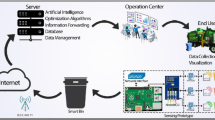Abstract
Occupancy detection is the main building block of residential and commercial building automation systems. Currently, it is difficult to determine when and where people occupy a commercial building. The accurate occupancy detection in the buildings is used to save energy. Hence, this paper presents an occupancy detection approach for detecting the person’s count in the room or building using the proposed Chaotic Whale Spider Monkey (ChaoWSM) + Deep stacked autoencoder. The input data are initially fed to the pre-processing step. The pre-processing is done using missing value imputation and log transformation. Then, the feature reduction is performed from the pre-processed data. Here, the features are reduced based on probabilistic principal component analysis. On the next step, the reduced features are fed to the occupancy detection module where the occupancy is detected on the basis of the support vector neural network classifier. If the occupancy is detected, the features are forwarded to the person’s count identification. The identification of a person’s count is carried out based on deep stacked autoencoder, which is trained by an optimization approach. The optimization is done using the proposed Chaotic Whale Spider Monkey (ChaoWSM) optimization, which is the integration of Chaotic Whale optimization and the spider monkey optimization. The performance of occupancy detection based on ChaoWSM + Deep stacked autoencoder is evaluated based on sensitivity, specificity, accuracy and MSE. The proposed ChaoWSM + Deep stacked autoencoder method achieves the maximal accuracy of 0.945, maximal sensitivity of 0.946, the maximal specificity of 0.949 and the minimal MSE of 0.233 by varying the training data percentage for deep stacked autoencoder.






Similar content being viewed by others
References
Bansal JC, Sharma H, Jadon SS, Clerc M (2014) Spider monkey optimization algorithm for numerical optimization. Memetic Comput 6(1):31–47
Bhambere SD (2011) Oral health status, knowledge and caries occurrence in visually impaired students. Int J Health Sci Res 7(11):118–121
Bhambere B (2017) "The long wait for health in India”—a study of waiting time for patients in a tertiary care hospital in Western India. Int J Basic Appl Res 7:108–111
Campi A, Guinea S, Spoletini P (2014) An operational semantics for XML fuzzy queries, vol 1. pp 206–210
Canakoglu A, Masseroli M, Ceri S, Tettamanti L, Ghisalberti G, Campi A (2013) Integrative warehousing of biomolecular information to support complex multi-topic queries for biomedical knowledge discovery. In: 13th IEEE international conference on bioinformatics and bioengineering, pp 1–4
Candanedo LM, Feldheim V (2016) Accurate occupancy detection of an office room from light, temperature, humidity and CO2 measurements using statistical learning models. Energy Build 112:28–39
Changyong FENG, Hongyue WANG, Naiji LU, Tian CHEN, Hua HE, Ying LU, Xin MT (2014) Log-transformation and its implications for data analysis. Shanghai Arch Psychiatry 26(2):105–109
Cristin R, Gladiss Merlin NR, Ramanathan L, Vimala S (2020) Image forgery detection using back propagation neural network model and particle swarm optimization algorithm. Multimed Res 3:1
Desogus M, Casu E (2019) A diagnostic approach to corporate sustainability based on normalized net margins and extended present value. Int J Financ Manag 9(2):1–8
Desogus M, Venturi B (2019) Bank crashes and micro enterprise loans. Int J Bus Soc Sci 10:12
Jayapriya K, Mary NAB (2019) Employing a novel 2-gram subgroup intra pattern (2GSIP) with stacked auto encoder for membrane protein classification. Molecular biology reports, pp1–14
Jeon Y, Cho C, Seo J, Kwon K, Park H, Oh S, Chung IJ (2018) IoT-based occupancy detection system in indoor residential environments. Build Environ 132:181–204
Kaur G, Arora S (2018) Chaotic whale optimization algorithm. J Comput Des Eng 5(3):275–284
Kleiminger W, Beckel C, Staake T, Santini S (2013) Occupancy detection from electricity consumption data. In: Proceedings of the 5th ACM workshop on embedded systems for energy-efficient buildings. ACM, pp 1–8
Kulikovskikh IM (2017) Cognitive validation map for early occupancy detection in environmental sensing. Eng Appl Artif Intell 65:330–335
Lam KP, Höynck M, Dong B, Andrews B, Chiou YS, Zhang R, Benitez D, Choi J (2009) Occupancy detection through an extensive environmental sensor network in an open-plan office building. IBPSA Build Simul 145:1452–1459
Ludwig O, Nunes U, Araujo R (2014) Eigenvalue decay: A new method for neural network regularization. Neurocomputing 124:33–42
Pedersen TH, Nielsen KU, Petersen S (2017) Method for room occupancy detection based on trajectory of indoor climate sensor data. Build Environ 115:147–156
Roselyn JP, Uthra RA, Raj A, Devaraj D, Bharadwaj P, Kaki SVDK (2019) Development and implementation of novel sensor fusion algorithm for occupancy detection and automation in energy efficient buildings. Sustain Cities Soc 44:85–98
Soltanaghaei E, Whitehouse K (2018) Practical occupancy detection for programmable and smart thermostats. Appl Energy 220:842–855
Swamy SM, Rajakumar BR, Valarmathi IR (2013) Design of hybrid wind and photovoltaic power system using opposition-based genetic algorithm with cauchy mutation. In: IET Chennai fourth international conference on sustainable energy and intelligent systems (SEISCON 2013), Chennai, India
Tipping ME, Bishop CM (1999) Probabilistic principal component analysis. J R Stat Soc Ser B (Stat Methodol) 61(3):611–622
Wang J, Tse NCF, Chan JYC (2019) Wi-Fi based occupancy detection in a complex indoor space under discontinuous wireless communication: a robust filtering based on event-triggered updating. Build Environ 151:228–239
Zou J, Zhao Q, Yang W, Wang F (2017) Occupancy detection in the office by analyzing surveillance videos and its application to building energy conservation. Energy Build 152:385–398
Zou H, Zhou Y, Yang J, Spanos CJ (2018) Device-free occupancy detection and crowd counting in smart buildings with WiFi-enabled IoT. Energy and Buildings 174:309–322
Author information
Authors and Affiliations
Corresponding author
Additional information
Publisher's Note
Springer Nature remains neutral with regard to jurisdictional claims in published maps and institutional affiliations.
Rights and permissions
About this article
Cite this article
Shirsat, K.P., Bhole, G.P. Optimization-enabled deep stacked autoencoder for occupancy detection. Soc. Netw. Anal. Min. 11, 30 (2021). https://doi.org/10.1007/s13278-021-00730-6
Received:
Revised:
Accepted:
Published:
DOI: https://doi.org/10.1007/s13278-021-00730-6




